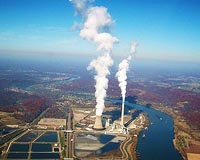 |
Copenhagen (AFP) Dec 7, 2009 Here are the main options for tackling greenhouse-gas emissions, listed by order of feasibility: - ENERGY EFFICIENCY: Improve energy efficiency in transport, buildings, appliances, lighting. ADVANTAGE: Can make big, early gains in braking growth in carbon pollution. DISADVANTAGE: Tougher standards may run into opposition from transport lobby, costs may meet consumer resistance. - CLEAN RENEWABLES: Wind, solar and hydro are the main sources, followed by biomass, geothermal, tidal and wave power. Hydrogen and fuel cells are promising but still distant as a commercial source. ADVANTAGES: Non-polluting, safe, free from geopolitical risk as the energy is derived from within the country and not imported. DISADVANTAGES: Entry costs still high, although those of wind have fallen fast and the efficiency of solar cells has improved; climate and geography may impose a niche role; large hydro projects contested because of environmental impact. - BIOFUELS: Transport fuel derived from plants saw a spectacular boom three years ago, driven by the United States' efforts to reduce its dependence on foreign oil. ADVANTAGE: Relatively low pollution. The plant sucks CO2 from the air in order to grow, and this CO2 is released when the fuel is burned. Additional emissions, though, come from using machinery to plant, harvest and process the crop. DISADVANTAGE: Present-generation biofuels are derived in part from corn, sugar and other crops which has helped drive up food prices. Next-generation biofuels, based on woodchips and fibrous plants, still only in pilot phase. - CARBON TAXES AND EMISSIONS CAPS: Levies on coal, oil and gas or statutory limits on emissions from these fuels. ADVANTAGE: Helps set a "carbon price" to reflect the environmental cost of fossil fuels, thus encouraging quick switch to cleaner energy. With a carbon price of 20-100 dollars per tonne of CO2, renewables could account for 30-25 percent of global energy supply by 2030, according to the UN's Intergovernmental Panel on Climate Change (IPCC). DISADVANTAGE: Could slow economic growth because of dependence on fossil fuels; resistance from vested interests, consumers. - CARBON CAPTURE AND SEQUESTRATION (CCS): Entails taking CO2, the heat-trapping by-product of combustion, at source from a coal-fired power station or oil refinery and piping the gas underground, storing it in deep geological chambers such as disused oilfields, rather than letting it escape into the atmosphere. ADVANTAGE: Would smooth the transition from carbon to hydrogen energy, especially as coal will be a major fuel for many decades to come. DISADVANTAGES: Still in pilot or small commercial phase; commercial costs unknown or high; difficult to retrofit to existing plants; long-term safety unclear -- a chamber breach could send a dangerous bubble of CO2 into the atmosphere. - NUCLEAR: Expansion of nuclear energy is being strongly promoted as a solution to the greenhouse-gas problem. ADVANTAGES: Very low greenhouse-gas emissions during operational lifespan; can reliably deliver very high volumes of electricity around the clock; geopolitical vulnerability low. DISADVANTAGES: Safety still under scrutiny after Chernobyl and Three Mile Island; fears about nuclear proliferation and terrorism; long-term storage of highly radioactive waste still unresolved. - GEO-ENGINEERING: Projects aimed at preventing or reversing global warming that once were considered outlandish but are increasingly getting a closer hearing. They include sowing the oceans with iron to encourage plankton to grow and thus dissolve more of the CO2 that the sea absorbs from the air at its surface; scattering particles in the upper atmosphere to reflect sunlight; and erecting a "sunshade" in space to cool Earth by a couple of degrees. ADVANTAGE: Would provide a quick fix to a problem that is evolving too fast to be addressed by politicians and imbedded fossil-fuel technology. DISADVANTAGES: Safety, effectiveness and cost are purely speculative. - DEMOGRAPHIC DECLINE: The world's 6.8 billion humans are already living way beyond their biological means. Without a technological revolution, carbon pollution and resource stress will hit a crunch by 2050, when numbers are expected to peak at as many as 9.7 billion. ADVANTAGE: Voluntarily braking or reversing population growth among big emitters would reduce the volume of greenhouse gases and thus gain time; among poorer countries, it would mean fewer people are exposed to impacts. DISADVANTAGES: Hard to achieve without parallel rise out of poverty (in some countries, large families are an old-age safety net); contraception and abortion opposed by some religions; demographic constraints opposed in many countries by natalist lobby. Share This Article With Planet Earth
Related Links
 Progress Energy Carolinas Plans To Retire Remaining Unscrubbed Coal Plants
Progress Energy Carolinas Plans To Retire Remaining Unscrubbed Coal PlantsRaleigh NC (SPX) Dec 03, 2009 Progress Energy Carolinas has announced that by the end of 2017, the company intends to permanently shut down all of its remaining N.C. coal-fired power plants that do not have flue-gas desulfurization controls (scrubbers). In a report filed with the N.C. Utilities Commission, the utility outlined its plan to close a total of 11 coal-fired units, totaling nearly 1,500 megawatts (MW) at four ... read more |
|
| The content herein, unless otherwise known to be public domain, are Copyright 1995-2009 - SpaceDaily. AFP and UPI Wire Stories are copyright Agence France-Presse and United Press International. ESA Portal Reports are copyright European Space Agency. All NASA sourced material is public domain. Additional copyrights may apply in whole or part to other bona fide parties. Advertising does not imply endorsement,agreement or approval of any opinions, statements or information provided by SpaceDaily on any Web page published or hosted by SpaceDaily. Privacy Statement |